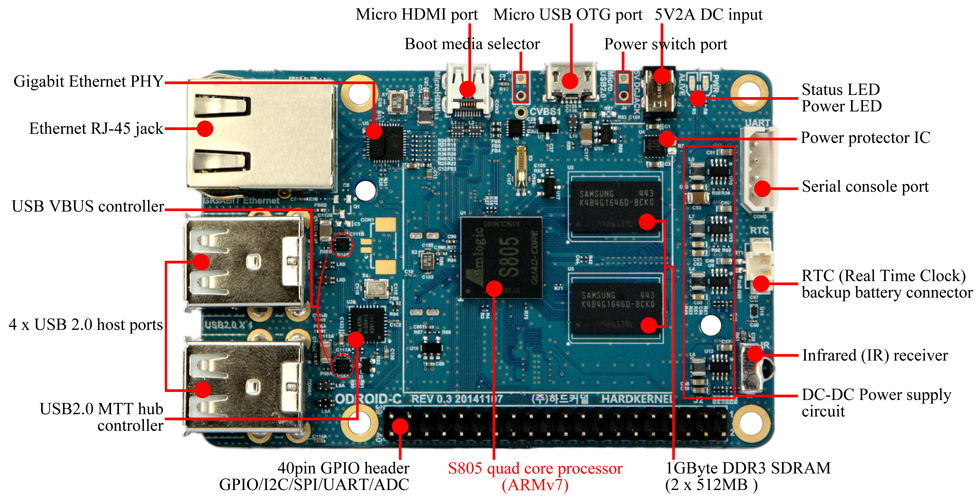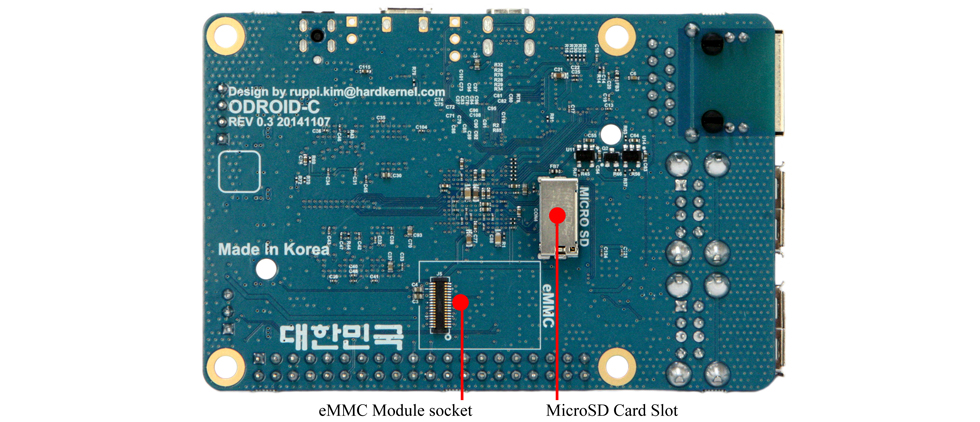2014-12-10, 12:01
Hardkernel just announced the "ODROID-C1" which is a $35 Development Board powered by AMLogic S805 SoC with Quad-Core Cortex-A5 (ARMv7) ARM CPU @ 1.5GHz :
www.hardkernel.com/main/products/prdt_info.php?g_code=G141578608433&tab_idx=1
http://odroid.com/dokuwiki/doku.php?id=en:odroid-c1
https://github.com/hardkernel/
Could this be the Raspberry Pi killer that many of us tinkers have been looking for that match its price and have much better performance and more RAM-memory?
http://magazine.odroid.com/assets/201412...201412.pdf
At least that what Hardkernel looks to be aiming for judging by the all the comparing they do of ODROID-C1 with the Raspberry Pi.
http://www.cnx-software.com/2014/12/10/h...processor/
Hardkernel ODROID-C1 is a $35 Development Board Powered by Amlogic S805 Quad Core Processor
Amlogic S805 is a quad core Cortex A5 processor which has found it way into low cost devices such as MK808B Plus TV Stick which can be purchased for as low as $30, or full-sized TV box such as MXQ S85 or MINIX NEO X6. All this low cost devices are nice, but the full source code is not available in your want to adapt them to your need. Luckily, Amlogic releases both an Android SDK, and a buildroot for Linux with GPU and Video Processing Unit (VPU) support, so Hardkernel decided to go ahead, designed a board, and has just launched ODROID-C1 quad core development board for just $35, or the exact price of a Raspberry Pi Model B+, but with much greater specs.
ODROID-C1 Board Description

ODROID-C1 specifications:
It’s the first S805 device I see that actually uses a Gigabit Ethernet port, so that’s good news. You can boot the system from eMMC or micro SD card, using the boot media selector (Open: eMMC, Closed: SD card).

The company will provide images for Ubuntu 14.04 or Android 4.4 KitKat with Linux 3.10. The source code for U-Boot/Linux will be released on December 15, but the Android source code will take a little longer due to license issues, and is expected for February. WiringPi v2 library used to control I/O in the Raspberry Pi with Python or C/C++, has been ported to ODROID-C1. Further information such an expansion header pinout, and instructions to build u-boot can be found on ODROID-C1 Wiki, which is still under construction. The schematics (PDF) and mechanical drawings have also been released.
What makes this platform existing, beside its attractive pricing and source code availability, is Ubuntu support with proper OpenGL ES and video hardware decoding support, which is showcased in the video below in Kodi 14 Helix running in Ubuntu 14.04.
ODROID-C1 is available for pre-order for $35 on Hardkernel website with shipping scheduled for December 16, but if you are based in North America or Europe, you should be better off purchasing from respectively Ameridroid or Pollin Electonic. [Update: Based on comments shipping is only $9]. You’ll also need to purchase storage for booting either from Hardkernel or its distributors which sells 8, 16, 32 and 64GB eMMC modules, or 8 to 16GB UHS-1 micro SD cards preloaded with Android 4.4 or Ubuntu 14.04, or buy it one locally, just make sure you don’t buy the cheapest micro SD card, get at least a Class 10 or UHS-1 micro SD, or your ODROID-C1 will feel as slow, or even slower, than a Raspberry Pi. Further details can also be found in ODROID magazine December 2014 (PDF) including a performance and specs comparison between ODROID-C1 and Raspberry Pi Model B+.
www.hardkernel.com/main/products/prdt_info.php?g_code=G141578608433&tab_idx=1
http://odroid.com/dokuwiki/doku.php?id=en:odroid-c1
https://github.com/hardkernel/
Could this be the Raspberry Pi killer that many of us tinkers have been looking for that match its price and have much better performance and more RAM-memory?
http://magazine.odroid.com/assets/201412...201412.pdf
At least that what Hardkernel looks to be aiming for judging by the all the comparing they do of ODROID-C1 with the Raspberry Pi.
http://www.cnx-software.com/2014/12/10/h...processor/
Hardkernel ODROID-C1 is a $35 Development Board Powered by Amlogic S805 Quad Core Processor
Amlogic S805 is a quad core Cortex A5 processor which has found it way into low cost devices such as MK808B Plus TV Stick which can be purchased for as low as $30, or full-sized TV box such as MXQ S85 or MINIX NEO X6. All this low cost devices are nice, but the full source code is not available in your want to adapt them to your need. Luckily, Amlogic releases both an Android SDK, and a buildroot for Linux with GPU and Video Processing Unit (VPU) support, so Hardkernel decided to go ahead, designed a board, and has just launched ODROID-C1 quad core development board for just $35, or the exact price of a Raspberry Pi Model B+, but with much greater specs.
ODROID-C1 Board Description

ODROID-C1 specifications:
- SoC- Amlogic S805 Quad Core ARM Cortex-A5 processor with a Dual Core Mali-450MP GPU
- System Memory – 1GBe DDR3 (2x Samsung K4B4G1646D)
- Storage – eMMC module socket for 8GB/64GB Toshiba eMMC, or 16GB/32GB Sandisk iNAND Extreme, and micro SD slot (UHS-1 SD models supported)
- Video & Audio Output – micro HDMI port
- Connectivity – Gigabit Ethernet (Realtek RTL8211F)
- USB – 4x USB 2.0 host ports (via GENESYS LOGIC GL852G), 1x micro USB OTG port (Cannot be used for power input)
- Expansion Headers – 40-pin Raspberry Pi (mostly) compatible header with GPIO, I2C, SPI, UART, and ADC.
- Debugging – Serial console header (3.3V)
- Misc – 4x Status / Power LEDS, IR receiver, RTC + RTC battery header, solder pads for power switch, boot media selector
- Power Supply – 5V/2A DC input (2.5/0.8mm barrel). Typical power consumption: 0.5A @ 5V, up to 2A @ 5V with several USB peripherals.
- Dimensions – 85 x 56mm (Same dimensions as Raspberry Pi Model B+)
- Weight – 40 gram
It’s the first S805 device I see that actually uses a Gigabit Ethernet port, so that’s good news. You can boot the system from eMMC or micro SD card, using the boot media selector (Open: eMMC, Closed: SD card).

The company will provide images for Ubuntu 14.04 or Android 4.4 KitKat with Linux 3.10. The source code for U-Boot/Linux will be released on December 15, but the Android source code will take a little longer due to license issues, and is expected for February. WiringPi v2 library used to control I/O in the Raspberry Pi with Python or C/C++, has been ported to ODROID-C1. Further information such an expansion header pinout, and instructions to build u-boot can be found on ODROID-C1 Wiki, which is still under construction. The schematics (PDF) and mechanical drawings have also been released.
What makes this platform existing, beside its attractive pricing and source code availability, is Ubuntu support with proper OpenGL ES and video hardware decoding support, which is showcased in the video below in Kodi 14 Helix running in Ubuntu 14.04.
ODROID-C1 is available for pre-order for $35 on Hardkernel website with shipping scheduled for December 16, but if you are based in North America or Europe, you should be better off purchasing from respectively Ameridroid or Pollin Electonic. [Update: Based on comments shipping is only $9]. You’ll also need to purchase storage for booting either from Hardkernel or its distributors which sells 8, 16, 32 and 64GB eMMC modules, or 8 to 16GB UHS-1 micro SD cards preloaded with Android 4.4 or Ubuntu 14.04, or buy it one locally, just make sure you don’t buy the cheapest micro SD card, get at least a Class 10 or UHS-1 micro SD, or your ODROID-C1 will feel as slow, or even slower, than a Raspberry Pi. Further details can also be found in ODROID magazine December 2014 (PDF) including a performance and specs comparison between ODROID-C1 and Raspberry Pi Model B+.
